Waiter/Waitress Salary in the United States
The average annual salary for a Waiter or Waitress in the USA is $36,530 per year + tips. Explore ideas for how to get a raise and increase your earnings in this guide.
But before learning all the essential information about Waiter/Waitress salaries, try out our comparison tool below. It lets you see how your current or desired salary as a Waiter/Waitress compares across major cities in the U.S.
How Much Does a Waiter or Waitress Earn in the United States?
The average base monthly wage for a Waiter or Waitress in the United States is $3,044.17, while the annual salary reaches $36,530. These numbers provide insight into typical compensation across the food service and dining industries.
Tips and gratuities make up a substantial portion of a Waiter’s or Waitress’s overall earnings, especially in sit-down restaurants where tips often range from 15% to 20% of the total bill. Fine dining establishments may offer even higher tipping potential.
How Much Do Waiters and Waitresses Earn per Week in the USA?
Using our Salary to Hourly Calculator, we’ve determined the average weekly salary for Waiters and Waitresses to be $702.50.
How Much Do Waiters and Waitresses Earn per Hour in the Restaurant Industry?
The average hourly wage for a Waiter/Waitress is $17.56 base plus tips.
However, some Waiters and Waitresses can earn as little as $8.94 (10th percentile) base plus tips per hour, while others may earn as much as $28.89 (90th percentile) base plus tips per hour.
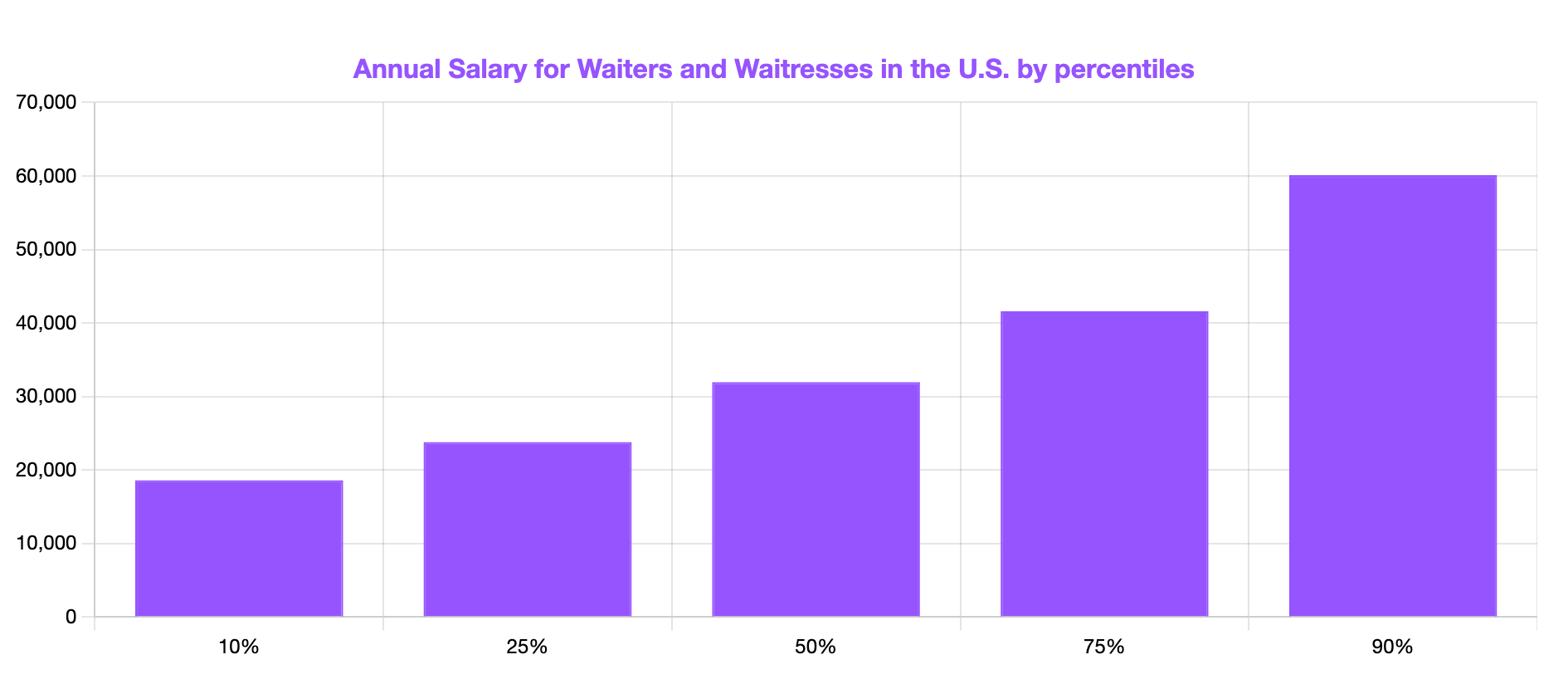
[Source: Bureau of Labor Statistics]
This chart is interactive. Hover your mouse over different parts of the chart to see detailed data.
If you’re in the 90th percentile, you earn more than 90% of all the Waiters and Waitresses in the United States. Meanwhile, if you’re in the 10th percentile, you earn less than 90% of the group.
Waiter/Waitress Salary by Year
The chart below shows the growth of Waiter/Waitress salaries from 2019 to 2023.
[Source: Bureau of Labor Statistics]
Waiters/Waitresses Salary by State
The annual income for Waiters and Waitresses varies greatly based on their location, with states like New York and California offering higher wages compared to Mississippi and Montana. Local cost of living and minimum wage laws directly affect these earnings.
For example, in states with high living expenses such as Vermont and Washington, Waiters and Waitresses typically earn higher wages to cope with the increased cost of living.
On the other hand, in states like Montana and Mississippi, where the cost of living is lower, Waiter/Waitress salaries may be more modest.
Moreover, states boasting famous tourist attractions or entertainment scenes, such as California and Florida, may provide more attractive wages to attract skilled Waiters and Waitresses, particularly during peak seasons.
The table below lists Waiter/Waitress salaries in all 50 states and the District of Columbia, sorted from highest to lowest.
Waiter/Waitress Salary in Major US Cities
Among the four major U.S. cities listed below, New York City pays Waiters and Waitresses the highest average salaries ($50,860), followed by Los Angeles, Miami and Chicago.
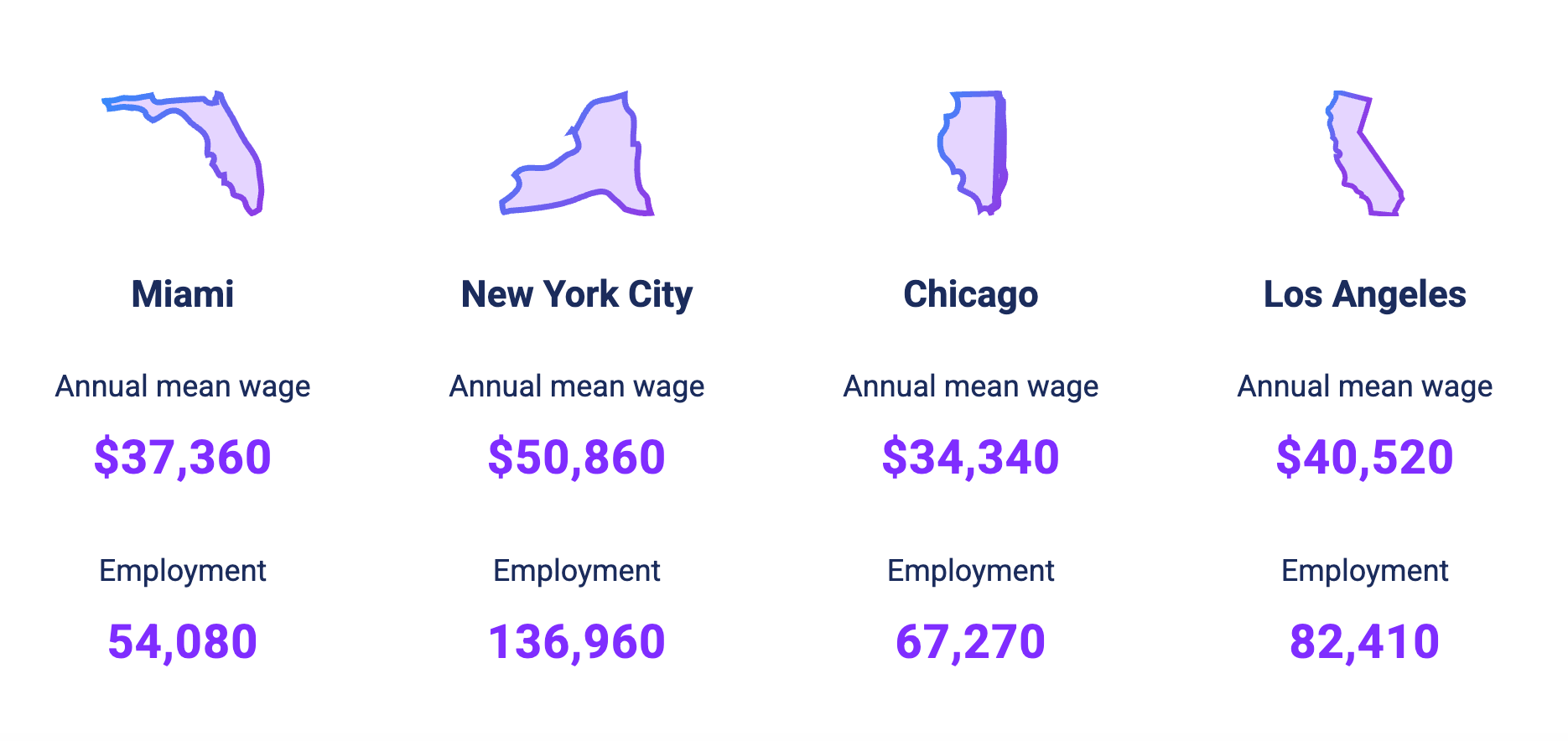
[Source: Bureau of Labor Statistics]
Factors That Affect Average Waiter/Waitress Salary
So, how much does a Waitress make a year? Here are a few factors that influence the average Waiter/Waitress salary in the U.S.:
Experience and Skills
Experienced Waiters and Waitresses who possess strong communication, customer service and multitasking skills often command higher salaries compared to entry-level workers. Those with additional skills such as knowledge of wine or cocktails may also earn more.
See also: How To Become a Waiter/Waitress With No Experience
Type of Establishment
The type of restaurant or dining establishment can significantly impact a Waiter/Waitress salary. Fine dining establishments or upscale restaurants typically pay higher wages compared to fast-food chains or casual dining venues.
Tips and Gratuity
Tips and gratuities form a substantial portion of a Waiter/Waitress income. The amount of tips can vary based on factors such as the restaurant's clientele, service quality and tipping culture in the region. The average Waiter salary with tips can be considerably higher in touristy spots like Florida, for example.
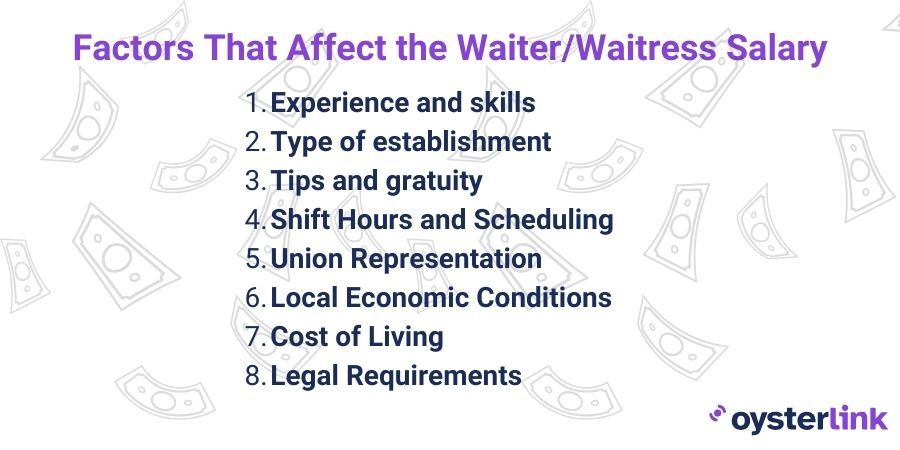
Shift Hours and Scheduling
Waiters and Waitresses who work during peak hours, weekends, or holidays can earn significantly more due to increased customer traffic and higher tip potential. Additionally, working at high-demand times in busy restaurants or tourist destinations often leads to increased earnings and larger gratuities.
Union Representation
In some regions, the waitstaff may be part of a union that negotiates wages and benefits on their behalf. Unionized Waiters and Waitresses often enjoy better pay and working conditions compared to their non-unionized counterparts.
Local Economic Conditions
The overall economic health of the area can influence Waiter/Waitress salaries. In areas with strong economies and low unemployment rates, restaurants may offer higher wages to attract and retain staff in a competitive labor market.
Cost of Living
The cost of living in any given area has a direct impact on the salaries offered to Waiters and Waitresses. In cities like San Francisco and New York, higher living expenses often translate to larger paychecks to accommodate housing, transportation, and other necessities.
Legal Requirements and Minimum Wage Laws
National or local minimum wage laws and regulations play a significant role in determining Waiter/Waitress salaries. Employers must adhere to these laws, which may vary widely between jurisdictions, ensuring compliance with labor standards that protect workers' rights.
How To Estimate Your Take-Home Pay as a Waiter/Waitress?
If you work as a Waiter or Waitress in the United States, use our Paycheck Calculator to determine the amount of money you’ll have left after taxes in your state.
All you need to do is:
- Input your salary.
- Select your pay frequency from the dropdown menu (annual, monthly, biweekly, weekly, daily or hourly).
- Choose your state.
- Click on the “calculate tax” button.
Non-Monetary Benefits and Perks for Waiters and Waitresses
In addition to their salary, Waiters and Waitresses may receive non-monetary perks and benefits designed to improve job satisfaction, promote work-life balance and facilitate professional development.
Here are some typical non-monetary perks and benefits that they may receive:
- Employee meals: Many restaurants offer free or discounted meals for their staff during shifts. This perk not only helps save money on food expenses but also ensures that Waiters and Waitresses are well-fed and energized for their work.
- Uniform allowance: Some establishments provide a uniform allowance or offer free uniforms to their employees. This helps maintain a professional appearance and reduces out-of-pocket expenses for staff members.
- Flexible scheduling: Flexible scheduling options allow Waiters and Waitresses to balance work commitments with personal responsibilities or other activities. This can include the option to request specific shifts or days off, accommodating employees' individual needs and preferences.
- Paid time off (PTO): Waiters and Waitresses often receive paid time off (PTO) for vacations, sick leave, or personal days, enabling them to take time off without losing income. Many restaurants offer additional perks like flexible schedules, retirement benefits, and health insurance.
- Retirement benefits: Some restaurants offer retirement savings plans such as a 401(k) with employer matching contributions. This allows employees to save for their future and build financial security over time.
- Training and development opportunities: Restaurants may offer training programs, workshops or seminars to enhance employees' skills and knowledge in areas such as customer service, food safety or wine appreciation. Investing in staff development not only benefits the individuals but also contributes to the overall success of the establishment.
- Health and wellness benefits: Some restaurants provide access to health and wellness benefits, such as gym memberships, counseling services or employee assistance programs. These resources support the physical and mental well-being of staff members, promoting a healthier and happier workforce.
- Recognition and rewards: Recognizing and rewarding outstanding performance can boost morale and motivation among Waiters and Waitresses. This can take the form of employee of the month awards, bonuses or other incentives based on performance metrics or customer feedback.
- Career advancement opportunities: Restaurants that prioritize employee development may offer opportunities for career advancement within the organization. This can include promotions to supervisory or management roles (e.g. Shift Supervisor or Assistant Restaurant Manager), providing a clear path for professional growth and advancement.
- Social events and team-building activities: Organizing social events or team-building activities fosters teamwork among restaurant staff. Whether it's a holiday party, team outing or volunteer opportunity, these events help build a supportive and cohesive work environment.
Salary Negotiation Tips for Waiters and Waitresses
Negotiating salary can be a nerve-wracking experience, but it’s an important step in landing a job that values your skills. Here are some tips to help you negotiate effectively:
- Know your worth: Research the going rates for Waiter/Waitress positions in your area. Pay can vary depending on the type of restaurant (fine dining vs. casual) and location, so gather as much information as possible before negotiating.
- Highlight your skills and experience: Emphasize your relevant experience, such as your ability to handle high-pressure environments, deliver excellent customer service and multitask effectively. If you have any additional qualifications (like food safety certifications), mention them to showcase your value.
- Look beyond just salary: Compensation isn’t limited to your base pay. Be sure to discuss tips, shift flexibility, paid time off or employee meal discounts, as these perks can greatly enhance your overall package.
- Be confident and professional: When asking for a higher wage, be clear and assertive about the reasons behind your request. Show confidence in your abilities while being respectful and open to compromise.
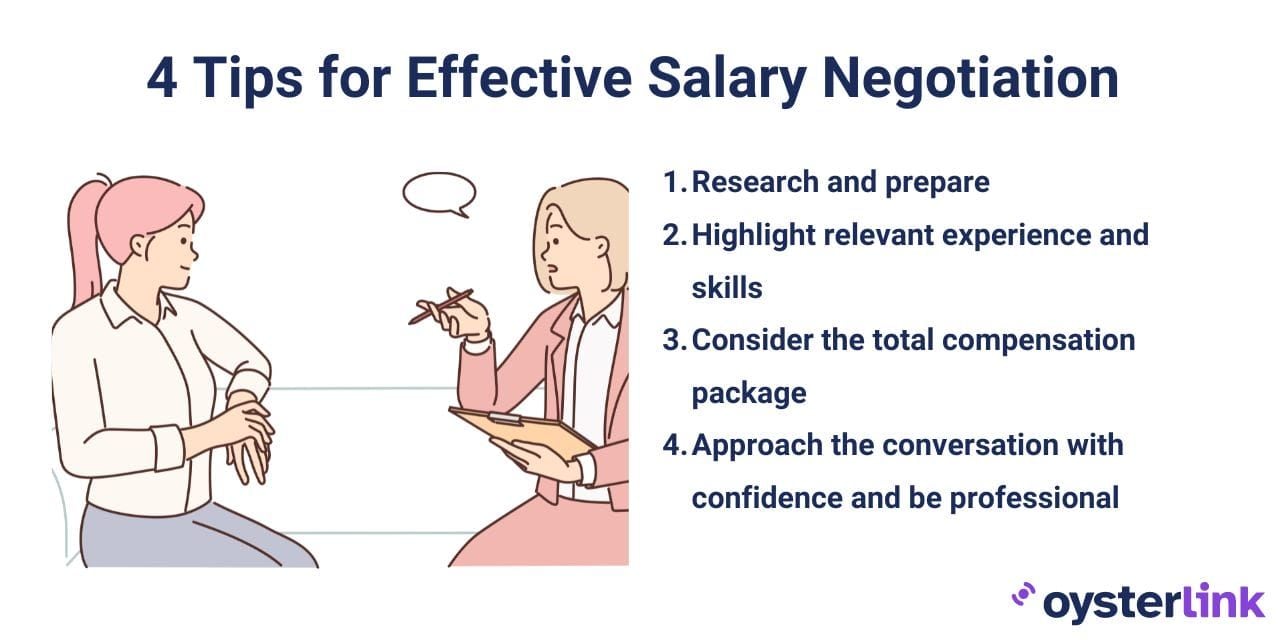
Top 10 Skills Needed for Waiters and Waitresses
As mentioned above, experienced Waiters and Waitresses who have mastered key skills tend to excel in their roles and earn higher salaries. These skills are essential because they contribute to delivering exceptional service and creating a memorable dining experience for customers.
Moreover, mastering these skills will not only make you a more effective Waiter or Waitress but can also open doors to better job opportunities and higher earnings.
So, if you're looking to stand out in this role, here are the top 10 skills you should focus on:
1. Effective Communication
Waiters and Waitresses need to communicate clearly and effectively with both customers and colleagues to ensure smooth interactions and foster positive relationships with patrons. This includes taking orders accurately, explaining menu items and addressing any questions or concerns customers may have.
2. Customer Service
Exceptional customer service is crucial for creating a positive dining experience. Waiters and Waitresses should possess strong communication skills, empathy and the ability to anticipate and fulfill customer needs promptly and courteously.
3. Attention to Detail
Attention to detail enhances customer satisfaction and helps prevent errors or misunderstandings. Waitstaff must accurately record orders, remember customer preferences and ensure that each dish is served correctly and according to the customer's specifications.
4. Ability to Handle Pressure
Working in a fast-paced restaurant environment can be demanding, especially during busy times. Waiters and Waitresses must remain calm and composed under pressure, efficiently managing multiple tasks and prioritizing responsibilities to ensure timely service. The ability to handle pressure gracefully contributes to a positive dining experience for customers.
5. POS System Proficiency
Proficiency in using the point-of-sale (POS) systems is essential for entering orders, processing payments and generating receipts accurately and efficiently. Waitstaff should be familiar with the layout and functions of the POS system to minimize errors and ensure smooth transactions.
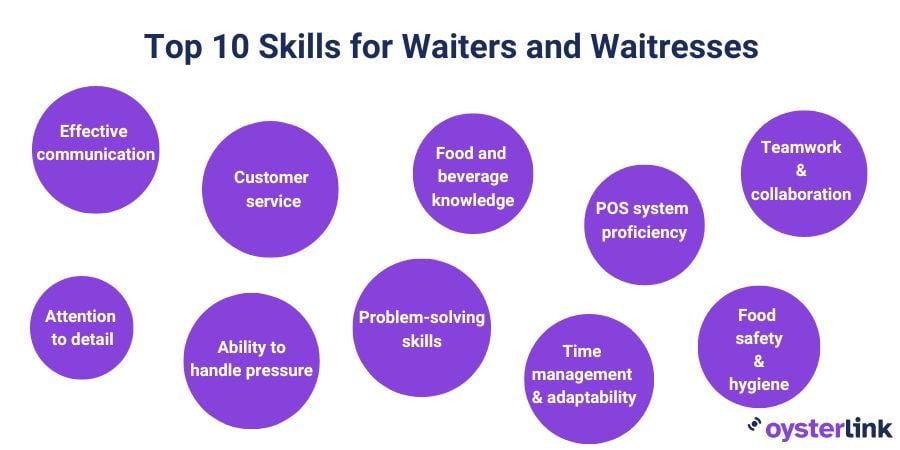
6. Food and Beverage Knowledge
A thorough understanding of the menu, including ingredients, preparation methods and potential allergens, is essential for providing informed recommendations and addressing customer inquiries. Waitstaff should also be knowledgeable about wine and other beverage options to offer suitable pairings.
7. Time Management and Adaptability
In a busy restaurant setting, effective time management and the ability to adapt to changing circumstances are essential skills for Waiters and Waitresses. They must prioritize tasks, manage multiple tables simultaneously and remain composed under pressure to provide timely and attentive service to all customers.
8. Teamwork and Collaboration
Collaboration among restaurant staff is vital for ensuring efficient service and a harmonious work environment. Waitstaff should be capable of working collaboratively with kitchen staff, Bartenders, Baristas and fellow Waiters to coordinate orders, expedite service and address any issues that may arise.
9. Problem-Solving Skills
Waitstaff must be capable of quickly and effectively resolving problems, such as incorrect orders, delays in service or customer complaints, as they arise, finding solutions that satisfy both the customer and the restaurant's policies. Strong problem-solving skills help maintain customer satisfaction and prevent minor issues from escalating.
10. Food Safety and Hygiene
Understanding and adhering to food safety and hygiene standards is critical for ensuring the health and well-being of customers. Waiters and Waitresses should be trained in proper food handling procedures, including safe storage, handling and serving practices, to prevent contamination and foodborne illness.
How Much Do Similar Careers to a Waiter/Waitress Get Paid?
Waiters and Waitresses in the United States earn less than Line Cooks but more than Barbacks and Food Runners.
 | Expert Reviewer Milos Eric thoroughly evaluated this salary guide to ensure the accuracy and comprehensiveness of the analyses provided. The salary guide provides insights such as location-specific figures, industry trends and factors that influence compensation. As the Co-Founder and General Manager of OysterLink, Milos brings his extensive experience as an entrepreneur and business executive. Through the years, he has led and hired more than 500 employees for global companies like DesignRush and Digital Silk. Not to mention, he is recognized as a Top Voice for Leadership, Recruitment and Recruitment Management on LinkedIn. |